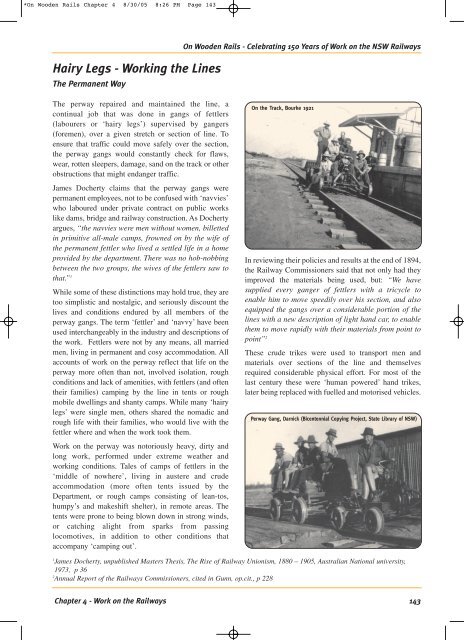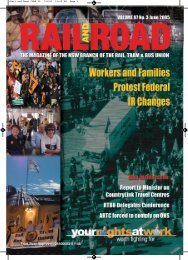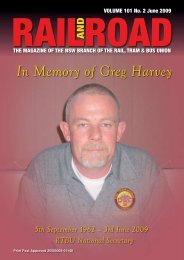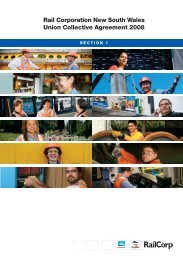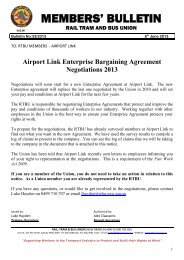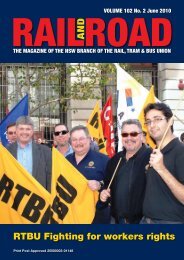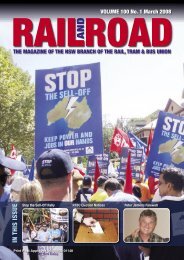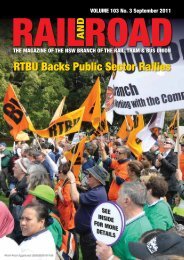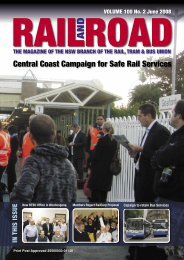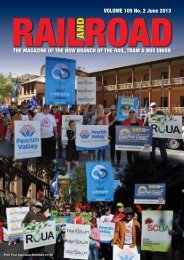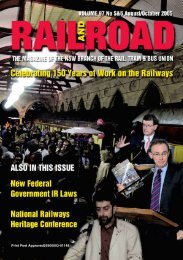Chapter 4 - Work on the Railways - Rail, Tram and Bus Union of NSW
Chapter 4 - Work on the Railways - Rail, Tram and Bus Union of NSW
Chapter 4 - Work on the Railways - Rail, Tram and Bus Union of NSW
Create successful ePaper yourself
Turn your PDF publications into a flip-book with our unique Google optimized e-Paper software.
*On Wooden <strong>Rail</strong>s <str<strong>on</strong>g>Chapter</str<strong>on</strong>g> 4 8/30/05 8:26 PM Page 143<br />
Hairy Legs - <str<strong>on</strong>g>Work</str<strong>on</strong>g>ing <strong>the</strong> Lines<br />
The Permanent Way<br />
The perway repaired <strong>and</strong> maintained <strong>the</strong> line, a<br />
c<strong>on</strong>tinual job that was d<strong>on</strong>e in gangs <strong>of</strong> fettlers<br />
(labourers or ‘hairy legs’) supervised by gangers<br />
(foremen), over a given stretch or secti<strong>on</strong> <strong>of</strong> line. To<br />
ensure that traffic could move safely over <strong>the</strong> secti<strong>on</strong>,<br />
<strong>the</strong> perway gangs would c<strong>on</strong>stantly check for flaws,<br />
wear, rotten sleepers, damage, s<strong>and</strong> <strong>on</strong> <strong>the</strong> track or o<strong>the</strong>r<br />
obstructi<strong>on</strong>s that might endanger traffic.<br />
James Docherty claims that <strong>the</strong> perway gangs were<br />
permanent employees, not to be c<strong>on</strong>fused with ‘navvies’<br />
who laboured under private c<strong>on</strong>tract <strong>on</strong> public works<br />
like dams, bridge <strong>and</strong> railway c<strong>on</strong>structi<strong>on</strong>. As Docherty<br />
argues, “<strong>the</strong> navvies were men without women, billetted<br />
in primitive all-male camps, frowned <strong>on</strong> by <strong>the</strong> wife <strong>of</strong><br />
<strong>the</strong> permanent fettler who lived a settled life in a home<br />
provided by <strong>the</strong> department. There was no hob-nobbing<br />
between <strong>the</strong> two groups, <strong>the</strong> wives <strong>of</strong> <strong>the</strong> fettlers saw to<br />
that.” 1<br />
While some <strong>of</strong> <strong>the</strong>se distincti<strong>on</strong>s may hold true, <strong>the</strong>y are<br />
too simplistic <strong>and</strong> nostalgic, <strong>and</strong> seriously discount <strong>the</strong><br />
lives <strong>and</strong> c<strong>on</strong>diti<strong>on</strong>s endured by all members <strong>of</strong> <strong>the</strong><br />
perway gangs. The term ‘fettler’ <strong>and</strong> ‘navvy’ have been<br />
used interchangeably in <strong>the</strong> industry <strong>and</strong> descripti<strong>on</strong>s <strong>of</strong><br />
<strong>the</strong> work. Fettlers were not by any means, all married<br />
men, living in permanent <strong>and</strong> cosy accommodati<strong>on</strong>. All<br />
accounts <strong>of</strong> work <strong>on</strong> <strong>the</strong> perway reflect that life <strong>on</strong> <strong>the</strong><br />
perway more <strong>of</strong>ten than not, involved isolati<strong>on</strong>, rough<br />
c<strong>on</strong>diti<strong>on</strong>s <strong>and</strong> lack <strong>of</strong> amenities, with fettlers (<strong>and</strong> <strong>of</strong>ten<br />
<strong>the</strong>ir families) camping by <strong>the</strong> line in tents or rough<br />
mobile dwellings <strong>and</strong> shanty camps. While many ‘hairy<br />
legs’ were single men, o<strong>the</strong>rs shared <strong>the</strong> nomadic <strong>and</strong><br />
rough life with <strong>the</strong>ir families, who would live with <strong>the</strong><br />
fettler where <strong>and</strong> when <strong>the</strong> work took <strong>the</strong>m.<br />
<str<strong>on</strong>g>Work</str<strong>on</strong>g> <strong>on</strong> <strong>the</strong> perway was notoriously heavy, dirty <strong>and</strong><br />
l<strong>on</strong>g work, performed under extreme wea<strong>the</strong>r <strong>and</strong><br />
working c<strong>on</strong>diti<strong>on</strong>s. Tales <strong>of</strong> camps <strong>of</strong> fettlers in <strong>the</strong><br />
‘middle <strong>of</strong> nowhere’, living in austere <strong>and</strong> crude<br />
accommodati<strong>on</strong> (more <strong>of</strong>ten tents issued by <strong>the</strong><br />
Department, or rough camps c<strong>on</strong>sisting <strong>of</strong> lean-tos,<br />
humpy’s <strong>and</strong> makeshift shelter), in remote areas. The<br />
tents were pr<strong>on</strong>e to being blown down in str<strong>on</strong>g winds,<br />
or catching alight from sparks from passing<br />
locomotives, in additi<strong>on</strong> to o<strong>the</strong>r c<strong>on</strong>diti<strong>on</strong>s that<br />
accompany ‘camping out’.<br />
On Wooden <strong>Rail</strong>s - Celebrating 150 Years <strong>of</strong> <str<strong>on</strong>g>Work</str<strong>on</strong>g> <strong>on</strong> <strong>the</strong> <strong>NSW</strong> <strong><strong>Rail</strong>ways</strong><br />
On <strong>the</strong> Track, Bourke 1921<br />
In reviewing <strong>the</strong>ir policies <strong>and</strong> results at <strong>the</strong> end <strong>of</strong> 1894,<br />
<strong>the</strong> <strong>Rail</strong>way Commissi<strong>on</strong>ers said that not <strong>on</strong>ly had <strong>the</strong>y<br />
improved <strong>the</strong> materials being used, but: “We have<br />
supplied every ganger <strong>of</strong> fettlers with a tricycle to<br />
enable him to move speedily over his secti<strong>on</strong>, <strong>and</strong> also<br />
equipped <strong>the</strong> gangs over a c<strong>on</strong>siderable porti<strong>on</strong> <strong>of</strong> <strong>the</strong><br />
lines with a new descripti<strong>on</strong> <strong>of</strong> light h<strong>and</strong> car, to enable<br />
<strong>the</strong>m to move rapidly with <strong>the</strong>ir materials from point to<br />
point” 2<br />
These crude trikes were used to transport men <strong>and</strong><br />
materials over secti<strong>on</strong>s <strong>of</strong> <strong>the</strong> line <strong>and</strong> <strong>the</strong>mselves<br />
required c<strong>on</strong>siderable physical effort. For most <strong>of</strong> <strong>the</strong><br />
last century <strong>the</strong>se were ‘human powered’ h<strong>and</strong> trikes,<br />
later being replaced with fuelled <strong>and</strong> motorised vehicles.<br />
Perway Gang, Darnick (Bicentennial Copying Project, State Library <strong>of</strong> <strong>NSW</strong>)<br />
1James Docherty, unpublished Masters Thesis, The Rise <strong>of</strong> <strong>Rail</strong>way Uni<strong>on</strong>ism, 1880 – 1905, Australian Nati<strong>on</strong>al university,<br />
1973, p 36<br />
2Annual Report <strong>of</strong> <strong>the</strong> <strong><strong>Rail</strong>ways</strong> Commissi<strong>on</strong>ers, cited in Gunn, op.cit., p 228<br />
<str<strong>on</strong>g>Chapter</str<strong>on</strong>g> 4 - <str<strong>on</strong>g>Work</str<strong>on</strong>g> <strong>on</strong> <strong>the</strong> <strong><strong>Rail</strong>ways</strong> 143


